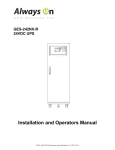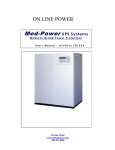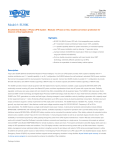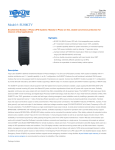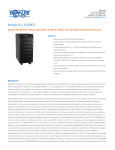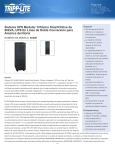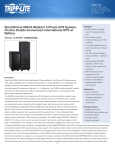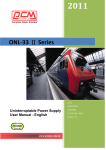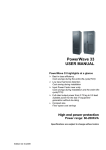Download Always "On" UPS NX-Series Specifications
Transcript
NX Series Three Phase UPS External Rotary Bypass Installation and Operators Manual UPC 00675 Version 1.0 Always On UPS Systems 2 Always On UPS Systems Table of Contents 1. CAUTION .................................................................................................................................... 4 2. IMPORTANT SAFETY INSTRUCTIONS ............................................................................... 5 3. UNPACKING .............................................................................................................................. 8 3.1. Transport ............................................................................................................................. 8 3.2. Delivery ................................................................................................................................ 8 3.3. Storage................................................................................................................................. 8 3.4. Site & Environment Consideration .................................................................................. 9 3.5. Unpacking .......................................................................................................................... 10 3.6. Cable Selection................................................................................................................. 11 4. BYPASS SYSTEMS LAYOUT DRAWINGS ....................................................................... 12 5. BYPASS WIRING DIAGRAMS ............................................................................................. 13 6. TERMINAL STRIP LAYOUT ................................................................................................. 15 7. OPERATION INSTRUCTIONS.............................................................................................. 16 7.1. From UPS to Bypass Operation .................................................................................... 16 7.2. From Bypass to UPS Operation .................................................................................... 16 8. DIMENSIONAL DRAWING .................................................................................................... 17 9. CONTACT INFORMATION.................................................................................................... 18 3 Always On UPS Systems 1. CAUTION This is a manual for Installation purposes only. Do not attempt the start up of the bypass or apply power to the input terminals. Factory authorized personnel shall inspect installation prior to start up and commissioning to validate warranty. Failure to follow this directive will result in void warranty. 4 Always On UPS Systems 2. IMPORTANT SAFETY INSTRUCTIONS READ AND FOLLOW ALL SAFETY INSTRUCTIONS. SAVE THESE INSTRUCTIONS. This manual contains important safety instructions that should be followed during installation and maintenance of the NX Series bypass system and optional packages. Before the installation process begins, we recommend that the installer read through the safety precautions, operators manual and the option installation instructions, taking all necessary safety precautions to protect themselves and the equipment being installed. GENERAL Move the bypass in an upright position, in its original packaging, to its final destination. To lift the cabinets, use a forklift or lifting belts with spreader bars. - Check for sufficient floor and elevator loading capacity. - Check the integrity of the bypass equipment carefully. If visible damage is evident, do not attempt to install or start the bypass. Contact the transport delivery company immediately, file a claim with the transport company and inform Always On directly. - Do not use outdoors - The use of accessory equipment not recommended by Always On may cause an unsafe condition - WARNING! RISK OF ELECTRICAL SHOCK: use extreme caution when removing covers. - All maintenance and service work should be performed by qualified and trained service personnel. The bypass may contain its own energy source, (batteries) which can be dangerous to the untrained person. This bypass contains potentially hazardous voltages - The field-wiring terminals may be electrically live, even when the bypass is not connected to the utility. - Use caution when servicing batteries. A battery can present a risk of electrical shock, burn from high short-current. Battery acid can cause burns to skin and eyes. If acid is spilled on skin or in eyes, flush with fresh water and contact physician immediately. - When replacing batteries use the same number and type (sealed-cell lead acid). - Proper disposal of batteries is required. Refer to your local codes for disposal requirements. - Dangerous voltages may be present during battery operation. The batteries must be disconnected during maintenance or service work. (Open battery breaker of fuses) - Be aware that the inverter can restart automatically after the utility voltage is restored. - Do not use this equipment for other than intended use. 5 Always On UPS Systems INSTALLATION - This bypass is intended for use in a controlled indoor environment free of conductive contaminants and protected against any type of intrusion. Do not install the bypass in an excessively humid environment or near water. Avoid spilling liquids and/or dropping any foreign object(s) onto the bypass. The unit must be placed in a sufficiently ventilated area; the ambient temperature should not exceed 40°C (104°F). Optimal battery life is obtained if the ambient temperature does not exceed 25°C (77°F). HIGH GROUND LEAKAGE CURRENT: ground connection completed before connecting the AC voltage wires on the input! Switching OFF the bypass does not isolate the bypass from the utility as the utility supply is still HOT at the input terminal strip. Supply breaker needs to be opened. It is important that air can move freely around and through the unit. Do not block the air vents. Avoid locations in direct sunlight or near heat sources (gas or electric heaters). STORAGE - Store the bypass in a dry location free of contaminants; Storage temperature must be within -25°C (-13°F) to 55°C (131°F). If the unit is stored for a period exceeding 3 months, the batteries must be recharged periodically (time depending on storage temperature). WARNING! LETHAL VOLTAGES MAY BE PRESENT WITHIN THIS UNIT EVEN WHEN IT IS APPARENTLY NOT OPERATING. OBSERVE ALL CAUTIONS AND WARNINGS IN THIS MANUAL. FAILURE TO DO SO COULD RESULT IN SERIOUS INJURY OR DEATH. REFER UNIT TO QUALIFIED SERVICE PERSONNEL IF MAINTENANCE IS REQUIRED. NO ONE SHOULD WORK ON THIS EQUIPMENT UNLESS THEY ARE FULLY QUALIFIED TO DO SO. AN INSTALLER SHOULD NEVER WORK ALONE. WARNING! WHEN REMOVING POWER FROM THE UPS, ALLOW FIVE MINUTES FOR CAPACITORS TO DISCHARGE BEFORE WORKING ON THE EQUIPMENT. CAUTION! This equipment complies with the requirements in Part 15 of FCC rules for a Class A computing device. Operation of this equipment in a residential area may cause interference to radio and TV reception, requiring the operator to take whatever steps necessary to correct the interference. CAUTION! Do not put option control wiring in the same conduit as the bypass input or output power cables. 6 Always On UPS Systems THIS SAFETY NOTICE IS ADDRESSED TO THE ALWAYS ON CUSTOMER ENGINEERS WHO PERFORM MAINTENANCE OF THE UNINTERRUPTIBLE POWER SUPPLY (UPS) SYSTEMS. Electrical Safety • Maintenance work to be preformed by factory trained customer engineers, or qualified personnel. Extremely dangerous voltage levels can exist within the bypass system. Extreme caution must be used. • Ensure system is in maintenance bypass mode or external wrap-around bypass mode before work is started. • This manual is designed as an aid tool in diagnosing problems that may arise. Always On does not assume responsibility if information causes injuries. • Apart from the front door, do not open any other part of the bypass without consulting the factory first. Before removing the protection screens, be sure that the unit is completely powered off. • Be aware that dangerous voltage can be supplied by the internal battery or electrolytic capacitors. • When system is in bypass mode and all fuses have been opened dangerous voltages may exist within the bypass system. Use extreme caution when exchanging boards and working inside the unit. READ AND FOLLOW ALL SAFETY INSTRUCTIONS. SAVE THESE INSTRUCTIONS. 7 Always On UPS Systems 3. UNPACKING 3.1. Transport The bypass is packaged on a pallet, suitable for handling with a forklift. Pay strict attention to the center of gravity. The bypass must be moved in upright position. Do not tilt cabinets more than +/- 10° during handling. Move the bypass in its original package to the final destination site. Do not stack other packages on top. If the bypass must be lifted by crane, use suitable lifting straps and spreader bars. 3.2. Delivery Upon receiving the bypass system, inspect the packaging integrity and the physical condition of the cabinets carefully. In the event that physical damage is visible, the carrier must be informed immediately and a claim filed with them. Inform Always On as soon as the claim has been filed and a copy of claim should be faxed to Always On at (250) 491-9775. A detailed report of the damage is necessary for carrier insurance claim. WARNING A damaged bypass system must never be installed or connected to the utility or batteries without written instruction from Always On Engineering. 3.3. Storage STORAGE OF THE BYPASS The bypass is carefully packed for transport and storage. Never leave a bypass outside the building exposed to the elements and do not place other packages on the top of the bypass. Storing: It is recommended to store the bypass in its original package in a dry, dust-free room, away from chemical substances, and with a temperature range of -25°C (-13°F) to 55°C (131°F). Exceeding this temperature range may cause damage. 8 Always On UPS Systems 3.4. Site & Environment Consideration The designed function of the bypass cabinet is to allow the UPS system to be shutdown and removed from the circuit without power interruption to the load. Usually the life expectancy of the Bypass system is 8 to 10 years. The optimal life expectancy of the Bypass system can be achieved by careful consideration of the site and environment. The following precautions and recommendations should be checked when considering the site and environment for the bypass: a. The bypass should be located in a place with adequate ventilation (refer to the specification of the heat dissipation of the bypass). Should the Bypass be installed in a sealed room, care must be taken to ensure adequate heat evacuation is provided. b. Void space is not required on all sides of the bypass system, but adequate space, a minimum of 1m (3’), should be allowed at the front for the door to open and a minimum of 60cm (2’) should be allowed on the right side to allow for the door to open and removal of the side panels for operation or maintenance purposes. Adequate space, a minimum of 60cm (2’) [recommended 1m (3’)], should also be allowed at the top of the bypass system to allow for proper heat dissipation and ventilated through the top openings (optional ventilation booth is available upon request). c. Do not place any objects on the top of the bypass that might obscure the ventilation. Do not place the bypass near any heat source, or machinery, which may produce metallic particles, dust or powder. Do not place the bypass near equipment that will produce corrosive substances or vapor. d. Do not place the bypass below the shower of a fire extinguishing system (optional drip shield available). Abnormal conditions of the bypass should be protected by a cutoff from the power supply. e. The user is required to guarantee the temperature and humidity values of the site into which the bypass will be installed, meet the required and published manufacturer specifications. The bypass should be installed within the range allowed by these specifications. The bypass is capable of continuous normal operation within a temperature range of 0°C (32°F) to 40°C (104°F). For optimal performance and reliability the recommended environment temperature is best at 25°C, with humidity < 80% noncondensing. f. The floor loading capacity should be sufficient to endure the weight of the UPS, bypass and battery bank. g. Walls, ceilings, floors or anything near to the bypass should be constructed of noncombustible materials. A portable fire extinguisher should be accessible nearby. 9 Always On UPS Systems h. Avoid accumulating litter or trash of any sort in or around the bypass system. The floor area surrounding the bypass should be kept clean, free from metallic powder and/or filings. i. Access to the bypass room should be limited to operation and maintenance personnel. The doors should be kept locked and the keys should be available only to authorized personnel. j. Personnel who operate or maintain the bypass system should be proficient in normal and emergency operational procedures. New personnel should be trained and qualified prior to operation of the equipment. 3.5. Unpacking Once in room of final destination, carefully remove all the packaging material from the bypass and place the bypass in its final position. This bypass system has passed all stages of production testing and final QC testing prior to shipment from the factory (report enclosed). The bypass should be in full operating condition upon receipt. Upon receiving visually check the bypass for any physical damage that may have occurred during transport. If damage is noticed file a damage report immediately with the transport company and inform Always On directly. Also check to ensure all of the accessories and/or options ordered are received. • • • DOOR KEY MANUAL OVER-RIDE SWITCH KEY (if equipped) OPERATOR’S MANUAL Check and verify the specifications of the bypass are identical to the specifications of the system ordered. The key items in the specifications you must check are: • • • RATED POWER OF THE BYPASS INPUT VOLTAGE & FREQUENCY OUTPUT VOLTAGE & FREQUENCY 10 Always On UPS Systems 3.6. Cable Selection The cabling of the bypass system has to be sized according to the UPS power rating. Sizing of circuit breakers, fuses and cables for input utility, output load and battery must meet the requirements of local and national electrical codes. WARNING Inadequate cable size and over sized breakers can increase the risk of fire or damage connection cables and internal components. 11 Always On UPS Systems 4. BYPASS SYSTEMS LAYOUT DRAWINGS Figure 4.1 Front view of system with Door Closed Single Wide Figure 4.2 Front view of system with Door Open Single Wide 12 Always On UPS Systems 5. BYPASS WIRING DIAGRAMS Figure 5.1 80kVA Bypass Schematic Figure 5.1 Bypass Schematic Single Line Drawing 13 Always On UPS Systems 6" 213 4" 4" BACK 9" CABLE ENTRANCE 1" 312 43 4" FRONT 12 3 " 16 BACK FRONT SIDE VIEW TOP VIEW OF BYPASS BASE 5" Terminal Block 22" Terminal Block 3" 14 4" 1" 82 CABLE ENTRANCE FRONT VIEW Figure 5.2 Bypass Power Cabling Diagram Terminal Block Diagram 14 Always On UPS Systems 6. TERMINAL STRIP LAYOUT BYPASS SWITCH TEST UPS IR IS IT BYPASS RED BLACK BLUE BYP TEST OA TB1 OB TO LOAD OC 3PH ON 4W+G RED BLACK BLUE UPS TEST UPS RED BLACK BLUE RED BLACK BLUE IN RED BLACK BLUE TB2 UTILITY INPUT 3PH 4W+G RED BLACK BLUE RR RS RT IN OR OS OT ON 3PH 4W+G TB1 FROM UPS OUTPUT 3PH 4W+G TB2 TO UPS INPUT UTILITY INPUT GROUND UPS INPUT UPS OUTPUT TO LOAD IR IS IT IN IN RR RS RT OR 0S OT ON ON OA OB OC IR IS IT IN IN RR RS RT OR 0S OT ON ON OA OB OC UTILITY INPUT TO UPS INPUT FROM UPS OUTPUT TO LOAD 15 Always On UPS Systems 7. OPERATION INSTRUCTIONS WARNING: The UPS System must be in Maintenance Bypass Mode. 7.1. From UPS to Bypass Operation a. Place the UPS into Maintenance Bypass mode (See UPS Operators Manual or instructions on the front cover of the UPS System). b. Turn the Rotary Switch to the Test Position. Note: Power is still present at the UPS terminals at the Test Position. c. Shutdown the UPS. (Follow the UPS Shutdown Instructions on the front cover of the UPS System). d. Turn the Rotary Switch to the Bypass Position. Note: This isolates the Power Supply to the UPS. 7.2. From Bypass to UPS Operation a. Turn the Rotary Switch to the Test Position. Note: This supplies power to the UPS terminals. b. Put the UPS in Maintenance Bypass mode (Follow the Maintenance Bypass Instructions on the front cover of the UPS System). c. Turn the Rotary Switch to the UPS Position. d. Turn the UPS to Normal Operating Mode (See the UPS Operators Manual or instructions on the front cover of the UPS System). 16 Always On UPS Systems 8. DIMENSIONAL DRAWING FRONT VIEW SIDE VIEW Figure 9.1 160KVA Exterior TOP VIEW 17 Always On UPS Systems 9. CONTACT INFORMATION QA / Warranty Questions Always On UPS Systems Inc. 1 – 150 Campion Road, Kelowna, BC, Canada, V1X 7S8 Phone: (250) 491-9777 Ext 209 Fax: (250) 491-9775 Email: [email protected] Website: www.alwayson.com Software Questions Always On UPS Systems Inc. 1 – 150 Campion Road, Kelowna, BC, Canada, V1X 7S8 Phone: (250) 491-9777 Ext 204 Fax: (250) 491-9775 Email: [email protected] Website: www.alwayson.com Additional Purchases or Upgrades Always On UPS Systems Inc. 1 – 150 Campion Road, Kelowna, BC, Canada, V1X 7S8 Phone: (250) 491-9777 Ext 451 Fax: (250) 491-9775 Email: [email protected] Website: www.alwayson.com 18 Always On UPS Systems 19



















